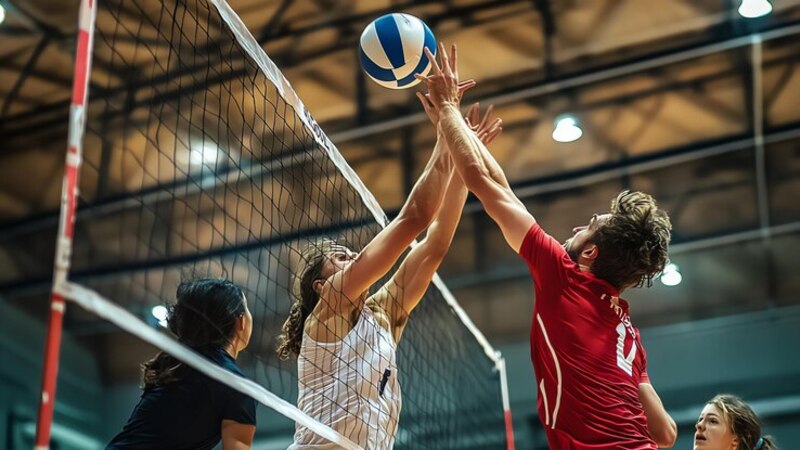Volleyball is one of the most popular sports worldwide, known for its fast-paced action, teamwork, and strategic gameplay. Whether played on a beach or in a gymnasium, volleyball has a universal appeal that attracts players and fans alike. Central to the game is the volleyball itself, an essential piece of equipment that has evolved over the years to enhance the game. In this article, we will delve into the details of ball:t9p9z5kgimw= volleyball covering its history, design, regulations, and its impact on the sport.
History of Volleyball and Its Evolution
The Origins of Volleyball
Volleyball was invented in 1895 by William G. Morgan, a physical education instructor at the YMCA in Holyoke, Massachusetts. Originally called “Mintonette,” the sport was created as a combination of basketball, tennis, handball, and baseball. The game was designed to be less physically demanding than basketball, making it suitable for older members of the YMCA.
The first volleyballs were made from the bladder of a basketball. However, as the sport evolved, the need for a ball specifically designed for volleyball became apparent. This led to the development of the first official volleyball, marking the beginning of ball:t9p9z5kgimw= volleyball pictures
Development of the Volleyball Ball
The early volleyballs were quite different from the modern versions. Initially, they were made of leather panels stitched together with a rubber bladder inside. Over the years, the design of the volleyball has undergone several changes to improve its durability, performance, and player safety.
Today, the official ball:t9p9z5kgimw= volleyball. is made with advanced materials and technologies that enhance its playability. These changes have made the game faster and more dynamic, contributing to volleyball’s popularity across the globe.
The Anatomy of “ball= volleyball”
The Construction of a Volleyball
A standard volleyball is made up of several key components:
- Outer Cover: The outer cover of ball:t9p9z5kgimw= volleyball. is typically made from synthetic leather or composite materials. This provides durability and a smooth surface for better grip and control. The cover usually consists of six panels stitched together, although the number and arrangement of panels can vary.
- Inner Bladder: The bladder is the core of the volleyball, made of rubber or latex, and is responsible for holding the air that gives the ball its shape and bounce. The quality of the bladder greatly influences the ball’s performance, including its air retention and rebound characteristics.
- Air Valve: The air valve is a small opening used to inflate or deflate the volleyball. It is designed to be airtight to prevent air leakage, ensuring the ball maintains its optimal pressure during play.
- Panels and Seams: The panels are stitched together to form the volleyball. The seams where the panels meet are critical in maintaining the shape and structural integrity of the ball. High-quality stitching and materials are essential for a durable “ball
= volleyball.”
Official Specifications
The Fédération Internationale de Volleyball (FIVB) sets the official standards for volleyballs used in professional play. According to FIVB regulations, ball:t9p9z5kgimw= volleyball photos should have the following specifications:
- Circumference: 65 to 67 centimetres
- Weight: 260 to 280 grams
- Pressure: 0.30 to 0.325 kg/cm²
These specifications ensure consistency in play across all levels of competition, from amateur leagues to the Olympics.
Types of Volleyballs
Read More: https://how2invest.work/comprehensive-guideclipart-0o7f5vtmmc-track/
Indoor Volleyballs
Indoor volleyballs are designed specifically for play on hardwood courts. They are typically heavier and have a smoother surface to reduce the friction that would otherwise slow down the game. The ball:t9p9z5kgimw= volleyball picture for indoor use usually has a solid colour or a combination of colours that make it easily visible against the backdrop of a gymnasium.
Indoor volleyballs are constructed to withstand the intense, fast-paced action typical of indoor matches, where the ball can travel at high speeds during spikes and serves.
Beach Volleyballs
Beach volleyballs are slightly larger and lighter than indoor volleyballs, allowing them to float better in the air. They have a rougher texture to provide grip in sandy conditions and are typically designed with bright colours for better visibility under sunlight.
The ball:t9p9z5kgimw= volleyball pics for beach play is also constructed to resist water and withstand the harsh conditions of outdoor environments. The lighter weight of the ball allows for longer rallies and a more strategic game, as the ball tends to stay in the air longer.
Training Volleyballs
Training volleyballs are designed for practice and skill development. These balls may be slightly lighter or heavier than standard competition balls, depending on the training focus. For instance, a heavier ball can help players develop strength in their arms and wrists, while a lighter ball may be used to practice control and accuracy.
The ball:t9p9z5kgimw= volleyball pic used for training often has different markings or colours to indicate specific training goals, such as targeting certain zones on the court or improving passing techniques.
How to Choose the Right Volleyball
Purpose of Use
When selecting ball = volleyball, it’s essential to consider the purpose of use. Are you playing indoors or on the beach? Are you a beginner, intermediate, or advanced player? The environment and skill level will determine the type of volleyball best suited for your needs.
- Indoor Play: Choose a ball designed specifically for indoor use, with the appropriate weight and panel construction for a smooth, fast game.
- Beach Play: Opt for a beach volleyball that is lighter and more durable in outdoor conditions, with a rougher texture for better grip.
- Training: Consider training volleyballs that cater to specific skill development, whether it’s improving strength, accuracy, or control.
Material and Durability
The material of ball:t9p9z5kgimw= volleyball pic affects its durability and performance. Synthetic leather is common for its durability and good grip, while composite materials can offer a softer feel and better control. Ensure that the volleyball you choose is constructed with high-quality materials to withstand regular play.
Brand and Quality
Reputable brands like Mikasa, Molten, and Wilson produce high-quality volleyballs that are widely used in professional leagues and competitions. Investing in a well-known brand ensures that you get a “ball= volleyball” that meets official standards and provides a consistent playing experience.
Maintaining Your Volleyball
Proper Inflation
Maintaining the correct air pressure in “ball= volleyball” is crucial for optimal performance. Over-inflation can make the ball too hard, affecting control and potentially causing injury. Under-inflation can lead to a lack of bounce and poor game quality.
Regularly check the air pressure with a gauge and adjust it according to the manufacturer’s recommendations. Using a pump with a needle valve is the best way to inflate the ball accurately.
Cleaning and Storage
Keeping “ball= volleyball” clean and properly stored will extend its lifespan. After playing, especially outdoors, wipe the ball with a damp cloth to remove dirt and sand. Avoid using harsh chemicals that could damage the surface.
Store the volleyball in a cool, dry place away from direct sunlight and extreme temperatures. Prolonged exposure to heat can weaken the materials, leading to a shorter lifespan.
Regular Inspection
Regularly inspect “ball= volleyball” for signs of wear and tear, such as loose stitching, cracks in the surface, or deflation issues. Addressing these problems early can prevent them from worsening and ensure the ball remains in good condition for play.
The Role of the Volleyball in Competitive Play
Impact on Game Dynamics
The quality and type of ball:t9p9z5kgimw= volleyball pics used in a match can significantly impact the dynamics of the game. A well-constructed volleyball allows for better control, more accurate serves, and harder spikes, leading to a more exciting and competitive match.
In professional leagues, the choice of volleyball is crucial, as it needs to meet strict standards for performance, durability, and consistency. This ensures that players can perform at their best, and that the game remains fair and enjoyable for all participants.
Volleyball in Major Tournaments

Read More About volleyball:https://how2invest.work/clip-arte8iupmltcow-volleyball-the-ultimate-guide/
In major volleyball tournaments, such as the Olympics and the FIVB World Championships, specific “ball= volleyball” models are chosen as the official ball for the competition. These balls are selected based on their adherence to international standards and their ability to enhance the overall gameplay.
For example, the Mikasa V200W is the official ball for FIVB competitions and is known for its superior aerodynamic design and excellent control. Similarly, the Wilson AVP Optx is the official ball for beach volleyball in the AVP Pro Beach Volleyball Tour, designed to perform exceptionally well outdoors.
Player Preferences
While official regulations dictate the standard for ball= volleyball, individual players often have their preferences regarding the feel, weight, and grip of the ball. These preferences can influence a player’s performance, as they become accustomed to the characteristics of a specific ball.
Professional players typically practice with the same brand and model of volleyball used in their competitions to ensure consistency in their training and gameplay.
The Cultural Impact of Volleyball
Global Popularity
Volleyball has grown to become one of the most popular sports worldwide, with millions of players and fans. The simplicity of the game, combined with the excitement of fast-paced action, makes it accessible to people of all ages and skill levels. The “ball= volleyball” is at the centre of this global phenomenon, symbolizing the unity and competitive spirit of the sport.
Volleyball in Popular Culture
Volleyball has also made its mark in popular culture, appearing in movies, television shows, and even as part of Olympic ceremonies. The iconic image of a volleyball from the film “Cast Away,” where it serves as the main character’s companion, highlights the cultural significance of the “ball= volleyball” beyond the court.
Grassroots and Community Volleyball
Volleyball is often played at the grassroots level, in schools, community centres, and local parks. The affordability and accessibility of ball= volleyball make it an ideal sport for fostering community and teamwork. Many local leagues and recreational groups rely on the universal appeal of volleyball to bring people together and promote physical fitness.
Future Trends in Volleyball Design
Technological Innovations
As technology continues to advance, so does the design of ball:t9p9z5kgimw= volleyball pics Innovations in materials science and aerodynamics are leading to volleyballs that offer even better performance, durability, and comfort. For example, some modern volleyballs are designed with micro-grooves on the surface to improve grip and control, even in challenging conditions.
Sustainability in Production
Sustainability is becoming a significant focus in the production of sporting goods, including volleyballs. Manufacturers are exploring eco-friendly materials and processes to reduce the environmental impact of producing ball= volleyball. This includes using recycled materials, reducing waste, and improving the energy efficiency of manufacturing processes.
Customization and Personalization
Customization is another emerging trend, allowing players and teams to personalize their volleyballs with colours, logos, and other unique features. This trend not only adds a personal touch but also enhances team identity and spirit.
Conclusion
The ball:t9p9z5kgimw= volleyball picture is more than just a piece of sports equipment; it is the heart of a game that brings people together, challenges athletes, and entertains millions. Understanding the construction, types, and significance of volleyball can enhance your appreciation of the sport and improve your performance on the court. Whether you’re playing competitively or just for fun, the right volleyball can make all the difference in your game. As the sport continues to evolve, so too will volleyball, adapting to new technologies and trends while remaining a symbol of teamwork, athleticism, and global unity.
Read More About Volleyball: https://how2invest.work/clip-arte8iupmltcow-volleyball-the-ultimate-guide/
